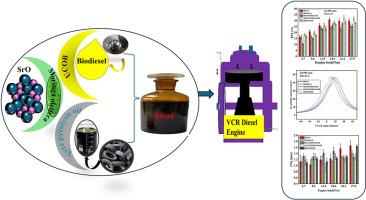Assessment of performance and emission characteristics of CI engine using tyre pyrolysis oil and biodiesel blends by nano additives: An experimental study
IF 5.6
2区 工程技术
Q2 ENERGY & FUELS
引用次数: 0
Abstract
In the current study, the diesel engine performance, emission, and combustion have been investigated using tyre pyrolysis oil (TPO) and biodiesel blended with nano-additives. The effect of the blending ratio on fuel combustion and emission was evaluated. The tyre pyrolysis oil was derived from scrap tyres through the pyrolysis process and biodiesel was synthesized from used cooking oil (UCO) through the transesterification process. Moringa oleifera-derived strontium oxide (SrO) nanoparticles were mixed into the fuel to provide extra oxygen for better combustion. Three blended fuels were formulated as: a) 5 % biodiesel and 95 % TPO containing 50 ppm SrO nanoparticles (B5TPO95SrO50), b) 10 % biodiesel and 90 % TPO containing 100 ppm SrO nanoparticles (B10TPO90SrO100), c) 50 % TPO and 50 % biodiesel without nano-additives (B50TPO50). Among the blended fuels, B10TPO90SrO100 showed the best brake thermal efficiency at 31.4 % and a brake-specific fuel consumption of 0.21 kg/kWh at full load. The B5TPO95SrO50 blended fuel showed reduced emission parameters such as unburned hydrocarbon (HC), carbon monoxide (CO), and oxides of nitrogen (NOx) by 2.05 %, 8.30 %, and 18.00 %, respectively, as compared to the conventional diesel engine at an optimum engine load (27.9 Nm). Hence, waste tyre oil and UCO biodiesel blended with biogenic SrO nano additive can be considered a promising fuel for a sustainable environment.

通过纳米添加剂评估使用轮胎热解油和生物柴油混合物的 CI 发动机的性能和排放特性:实验研究
在当前的研究中,使用轮胎热解油(TPO)和掺有纳米添加剂的生物柴油对柴油发动机的性能、排放和燃烧进行了研究。研究还评估了混合比例对燃料燃烧和排放的影响。轮胎热解油是通过热解工艺从废轮胎中提取的,而生物柴油则是通过酯交换工艺从废食用油中合成的。燃料中混入了从油杉中提取的纳米氧化锶(SrO)颗粒,以提供额外的氧气,从而改善燃烧。配制了三种混合燃料:a) 5 % 生物柴油和 95 % 热塑性烯烃,其中含有 50 ppm 的纳米氧化锶(B5TPO95SrO50);b) 10 % 生物柴油和 90 % 热塑性烯烃,其中含有 100 ppm 的纳米氧化锶(B10TPO90SrO100);c) 50 % 热塑性烯烃和 50 % 生物柴油,其中不含纳米添加剂(B50TPO50)。在混合燃料中,B10TPO90SrO100 的制动热效率最高,为 31.4%,满负荷时的制动油耗为 0.21 kg/kWh。与传统柴油发动机相比,B5TPO95SrO50 混合燃料在最佳发动机负荷(27.9 牛米)下的未燃碳氢化合物(HC)、一氧化碳(CO)和氮氧化物(NOx)等排放参数分别降低了 2.05 %、8.30 % 和 18.00 %。因此,废轮胎油和 UCO 生物柴油与生物源氧化锶纳米添加剂混合后,可被视为一种有前途的可持续环境燃料。
本文章由计算机程序翻译,如有差异,请以英文原文为准。
求助全文
约1分钟内获得全文
求助全文
来源期刊

Journal of The Energy Institute
工程技术-能源与燃料
CiteScore
10.60
自引率
5.30%
发文量
166
审稿时长
16 days
期刊介绍:
The Journal of the Energy Institute provides peer reviewed coverage of original high quality research on energy, engineering and technology.The coverage is broad and the main areas of interest include:
Combustion engineering and associated technologies; process heating; power generation; engines and propulsion; emissions and environmental pollution control; clean coal technologies; carbon abatement technologies
Emissions and environmental pollution control; safety and hazards;
Clean coal technologies; carbon abatement technologies, including carbon capture and storage, CCS;
Petroleum engineering and fuel quality, including storage and transport
Alternative energy sources; biomass utilisation and biomass conversion technologies; energy from waste, incineration and recycling
Energy conversion, energy recovery and energy efficiency; space heating, fuel cells, heat pumps and cooling systems
Energy storage
The journal''s coverage reflects changes in energy technology that result from the transition to more efficient energy production and end use together with reduced carbon emission.
 求助内容:
求助内容: 应助结果提醒方式:
应助结果提醒方式:


